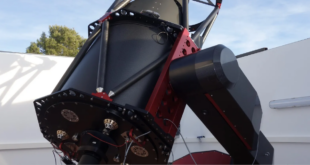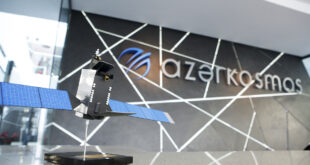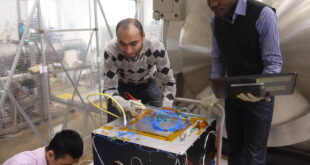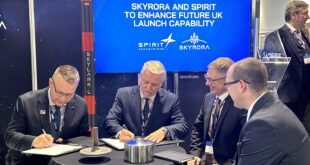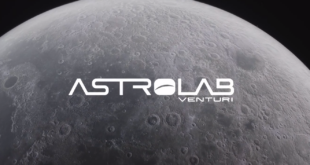The UK Space Command and the UK Space Agency have announced the award of a contract to Spaceflux to build a new ground-based space camera-telescope system in Cyprus to monitor objects in geostationary orbit, approximately 36,000km above Earth’s equator. the telescope's mission will be to provide position information on UK satellites, helping to prevent collisions, protect critical space assets, and enhance the UK’s Space Domain Awareness (SDA).
Read More »Space Café Radio – the Space above Scotland – with Richard Lochhead, MSP
In this Space Café Radio - SpaceWatch.Global publisher Torsten Kriening spoke with Richard Lochhead, Member of the Scottish Parliament and Minister for Small Business, Innovation, Tourism and Trade just before the Space Tech Expo Europe in Bremen. Torsten and Minister Lochhead spoke about the space industry in Scotland. Mr Lochhead highlights the rapid growth and impact of the space sector in Scotland, particularly in manufacturing small satellites. He mentions the presence of companies like Spire, AAC Clyde Space, and Mangata, which contribute to Scotland's reputation as a satellite manufacturing hub.
Read More »Space Café BeNeLux by Dr. Heike Poignand: Kees Buijsrogge on “How space technology is key for Europe’s sovereignty?”
In the most recent episode of “Space Café BeNeLux”, our host Dr. Heike Poignand, welcomed Kees Buijsrogge, Director High Tech for Civil & Military Space at TNO to an open discussion around the delicate topic how space technology is key for Europe’s sovereignty? The conversation highlighted the significance of space in Europe's sovereignty, the methods employed to achieve it—such as programs like IRIS²—and the integral role space plays in our daily life, impacting innovation and competitiveness, that are crucial especially for smaller nations like The Netherlands.
Read More »Azercosmos and AEB sign MOU for Space Initiatives
Azercosmos, the Space Agency of the Republic of Azerbaijan, and the Brazilian Space Agency (AEB) have signed a Memorandum of Understanding (MoU) on space cooperation. The MoU envisages Brazil-Azerbaijan collaboration in space science, technology, and application and will serve as an instrument to establish a framework for future cooperation in the domain of outer space
Read More »UNOOSA and Japan Announce PNST Fellowship Opportunity
The United Nations Office for Outer Space Affairs (UNOOSA) and the Government of Japan, in cooperation with the Kyushu Institute of Technology (Kyutech), are providing opportunities for students from developing countries to study nano-satellite development. As a result, the Post-graduate Study on Nano-Satellite Technologies (PNST) Fellowship Program is making three slots in the Master Programme and three slots in the Doctoral Programme available. The program will also cover tuition fees and provide a stipend to cover living expenses. As a result, students are invited to submit their applications by 5 January 2024 and follow in the footsteps of more than 60 graduates over the years.
Read More »The Space Café Podcast #94: Diving into NASA’s DART Mission: Lead Investigator Andy Rivkin on the Frontlines of Planetary Defense
Join us in this episode of Space Cafe Podcast as Markus Mooslechner talks with Andy Rivkin about the thrilling DART mission. As its Lead Investigator, Rivkin offers a rare glimpse into the world of planetary defense, sharing the intricate dance between meticulously executed plans and the unpredictable nature of space exploration. From the collision course with Dimorphos to the anticipation of Hera's future findings, Rivkin’s narrative is a testament to human ingenuity and our relentless pursuit of cosmic knowledge.
Read More »Space Café Austria by Sabine Pongruber – with Markus Mooslechner
In the latest “Space Café Austria”, hosted by Sabine Pongruber, CEO of WEME Global, welcomed Markus Mooslechner on 10 November 2023. "Anyone can be a good storyteller, because everyone has a story to tell." Embark on a Journey of Discovery with Markus, an Award-Winning Storyteller and Science Communicator! Immerse yourself in an engaging conversation that explores the depths of genuine human interaction and the craft of storytelling.
Read More »UNIO Achieves Connectivity Switch in Connected Vehicles
UNIO has announced the successful test of its ‘Powered by UNIO’ bridge product for connected vehicles as the Munich-based company achieved a seamless switch from 5G to satellite connectivity. During a live demonstration in Munich on November 20, a vehicle demonstrated a seamless transition between a connected 5G data rate and an equivalent data rate satellite connection. This demonstration featured a 'bridge' installation, and the transition occurred without any interruption to the data connection.
Read More »Skyrora and Spirit to Enhance Future UK Launch Capability
Skyrora and Spirit AeroSystems have announced a collaboration on orbital launch capability. The companies celebrated the announcement on the conference’s opening day in Belfast, home to Spirit’s largest UK manufacturing facility. This partnership will enable Skyrora to transition its orbital launch vehicles from development to full-scale production, in addition to localizing its supply chain.
Read More »Astrolab Announce Eight Partners for its Moon Mission
Venturi Astrolab, Inc. (Astrolab) has announced that it has reached an agreement with eight enterprise customers to use its Flexible Logistics and Exploration (FLEX) rover to deploy the customers’ payloads on Astrolab’s upcoming mission to the Moon - Mission 1. Five customers are releasing details of their payloads today: Argo Space, Astroport, Avalon Space, Interstellar Lab, and LifeShip. Three more customers are contracted with Astrolab but intend to release details of their payloads at a future date, closer to launch. Collectively, Astrolab values the eight contracts at more than $160 million.
Read More » SpaceWatch.Global An independent perspective on space
SpaceWatch.Global An independent perspective on space

